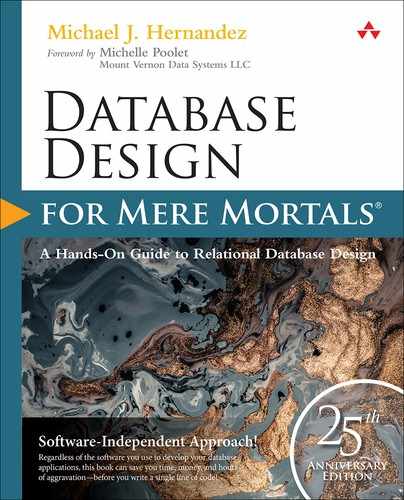Contents
What’s New in the Fourth Edition
A Word about the Examples and Techniques in This Book
PART I: RELATIONAL DATABASE DESIGN
Chapter 1: The Relational Database
Topics Covered in This Chapter
Advantages of a Relational Database
Relational Database Management Systems
Topics Covered in This Chapter
Why Should You Be Concerned with Database Design?
The Advantage of Learning a Good Design Methodology
The Design Method Presented in This Book
Topics Covered in This Chapter
Why This Terminology Is Important
Chapter 4: Conceptual Overview
Topics Covered in This Chapter
The Importance of Completing the Design Process
Defining a Mission Statement and Mission Objectives
Analyzing the Current Database
Determining and Establishing Table Relationships
Determining and Defining Business Rules
Determining and Defining Views
Chapter 5: Starting the Process
Topics Covered in This Chapter
Interviewer Guidelines (These Are for You)
Defining the Mission Statement
The Well-Written Mission Statement
Defining the Mission Objectives
Well-Written Mission Objectives
Chapter 6: Analyzing the Current Database
Topics Covered in This Chapter
Getting to Know the Current Database
Looking at How Data Is Collected
Looking at How Information Is Presented
Before You Begin the Interview Process . . .
Reviewing Information Requirements
Reviewing Current Information Requirements
Reviewing Additional Information Requirements
Reviewing Future Information Requirements
Reviewing Overall Information Requirements
Compiling a Complete List of Fields
Reviewing Both Lists with Users and Management
Chapter 7: Establishing Table Structures
Topics Covered in This Chapter
Defining the Preliminary Table List
Composing the Table Descriptions
Associating Fields with Each Table
Using an Ideal Field to Resolve Anomalies
A Word about Redundant Data and Duplicate Fields
Using an Ideal Table to Refine Table Structures
Topics Covered in This Chapter
Establishing Keys for Each Table
Reviewing the Initial Table Structures
Chapter 9: Field Specifications
Topics Covered in This Chapter
Why Field Specifications Are Important
Anatomy of a Field Specification
Using Unique, Generic, and Replica Field Specifications
Defining Field Specifications for Each Field in the Database
Chapter 10: Table Relationships
Topics Covered in This Chapter
Why Relationships Are Important
Self-Referencing Relationships
Identifying Existing Relationships
Establishing Each Relationship
One-to-One and One-to-Many Relationships
Self-Referencing Relationships
Reviewing the Structure of Each Table
Establishing Relationship Characteristics
Defining a Deletion Rule for Each Relationship
Identifying the Type of Participation for Each Table
Identifying the Degree of Participation for Each Table
Verifying Table Relationships with Users and Management
Topics Covered in This Chapter
Relationship-Specific Business Rules
Defining and Establishing Business Rules
Working with Users and Management
Defining and Establishing Field-Specific Business Rules
Defining and Establishing Relationship-Specific Business Rules
Using Validation Tables to Support Business Rules
Reviewing the Business Rule Specifications Sheets
Topics Covered in This Chapter
Determining and Defining Views
Working with Users and Management
Reviewing the Documentation for Each View
Chapter 13: Reviewing Data Integrity
Topics Covered in This Chapter
Why You Should Review Data Integrity
Reviewing and Refining Data Integrity
Assembling the Database Documentation
PART III: OTHER DATABASE DESIGN ISSUES
Chapter 14: Bad Design—What Not to Do
Topics Covered in This Chapter
Dealing with the Spreadsheet View Mindset
Database Design Based on the Database Software
Chapter 15: Bending or Breaking the Rules
Topics Covered in This Chapter
When May You Bend or Break the Rules?
Designing an Analytical Database
Improving Processing Performance
Appendix A: Answers to Review Questions
Appendix B: Diagram of the Database Design Process
Appendix D: Documentation Forms
Appendix E: Database-Design Diagram Symbols
